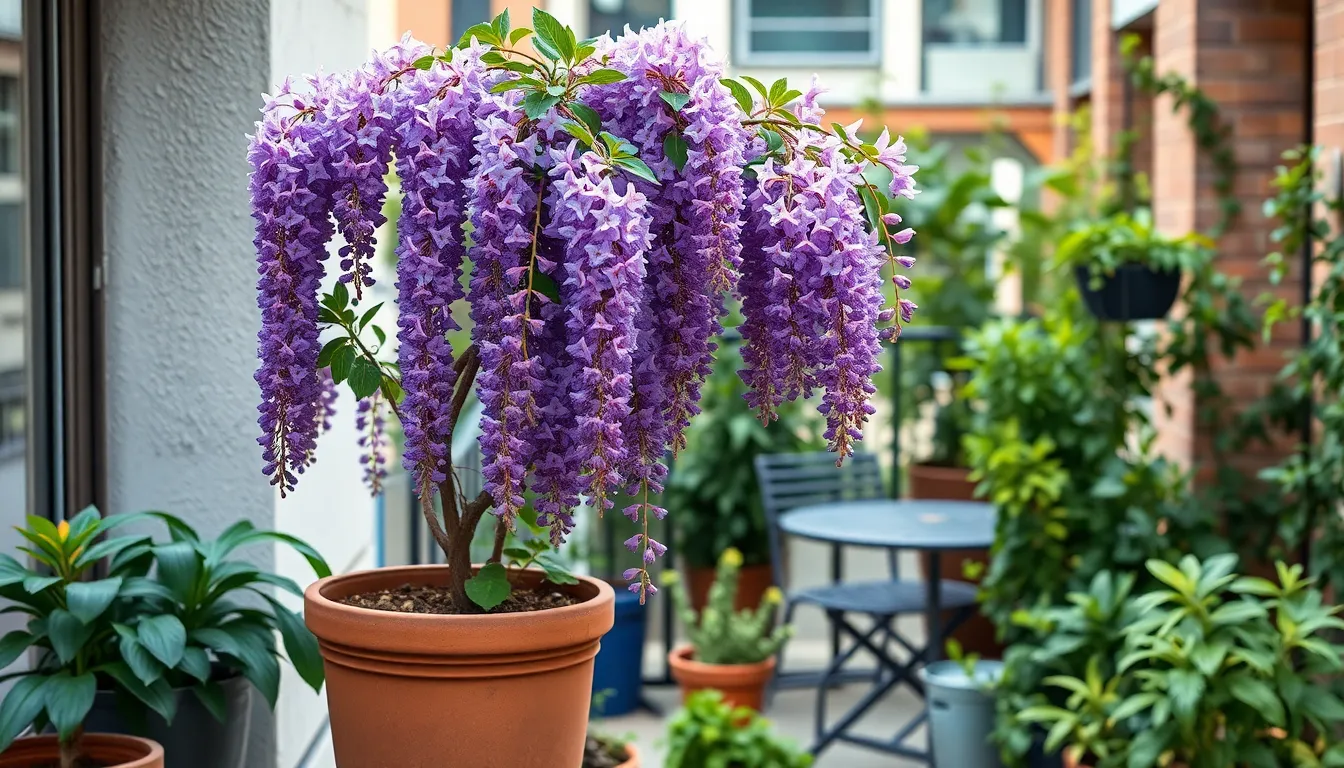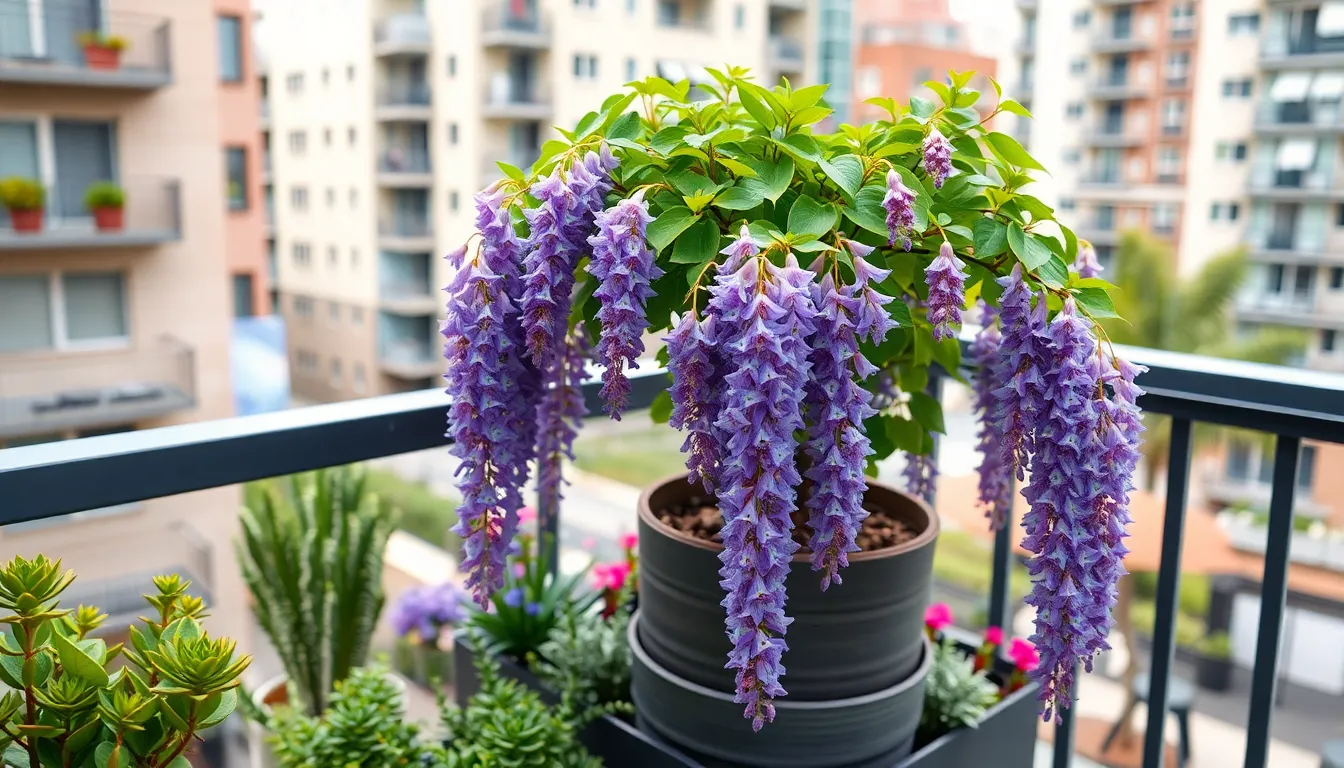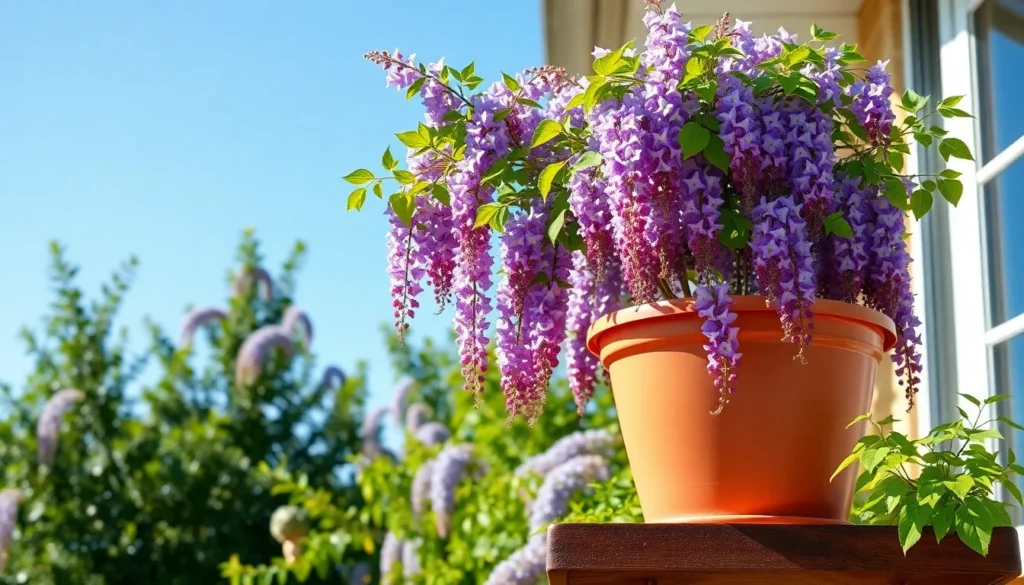Table of Contents
ToggleWisteria—a name that conjures images of cascading purple blooms and dreamy garden escapes. But what if you don’t have a sprawling backyard? Fear not! Growing wisteria in a pot might just be the solution to your floral fantasies. Imagine stepping onto your balcony or patio, greeted by the sweet scent and stunning colors of this climbing beauty, all without the commitment of a full garden.
But can you really keep this vigorous vine contained? The answer’s a resounding yes, with a few caveats. With the right pot, soil, and care, you can enjoy the elegance of wisteria without it taking over your entire living space. So grab your gardening gloves and let’s dive into the delightful world of container gardening with wisteria—where even the smallest spaces can bloom with beauty.
Overview of Wisteria
Wisteria belongs to the Fabaceae family and is known for its stunning cascading blooms. It primarily thrives in temperate regions and offers magnificent flowers that can vary in color, including purple, blue, pink, and white. Common species include Japanese wisteria (Wisteria floribunda) and Chinese wisteria (Wisteria sinensis), both renowned for their fragrant clusters.
Growth habits are vigorous, with some species capable of reaching heights of 30 feet or more if unrestricted. While its climbing nature makes wisteria an excellent choice for trellises, fences, or arbors, using pots presents unique cultivation challenges that require consideration.
Traditionally, wisteria flourishes in the ground, where roots can spread freely. Pot culture restricts root growth, demanding careful management of soil, water, and nutrients. Choosing a pot with adequate drainage promotes healthy growth, while using well-draining potting mix with organic matter enhances fertility.
Light requirements also play a critical role in wisteria cultivation. Full sun exposure, typically around six to eight hours daily, encourages the production of vibrant flowers. When kept in pots, it’s essential to rotate them occasionally to ensure even light distribution.
Pruning techniques shape the plant’s growth and stimulate flowering. Regular pruning in late winter or early spring controls size and encourages productivity. Being mindful of the plant’s needs leads to a flourishing display even in limited spaces. For those keen on cultivating wisteria in pots, knowledge and dedication promise successful, rewarding growth.
Benefits of Growing Wisteria in a Pot


Growing wisteria in a pot offers unique advantages, especially for those with limited outdoor space. Container gardening not only maximizes available areas but also allows for versatile placements.
Space Efficiency
Containerized wisteria thrives in compact environments. Smaller gardens or balconies benefit significantly from the ability to control growth and root spread. Pots featuring proper drainage encourage healthy root systems without overwhelming space. Relocating pots can adapt to seasonal sunlight changes, ensuring optimal growth conditions. This flexibility makes urban gardening accessible and manageable, allowing homeowners to enjoy gardening without substantial land.
Aesthetic Appeal
Wisteria’s striking blooms create stunning visual displays, perfect for enhancing patios or balconies. Cascading flowers provide an eye-catching focal point in limited spaces. Container gardening allows for strategic placements near outdoor seating or entrances, elevating overall ambiance. Colorful and fragrant, wisteria not only beautifies environments but also attracts pollinators, turning small areas into vibrant garden spots. With care, wisteria transforms any confined setting into an enchanting retreat.
Choosing the Right Pot
Selecting the right pot is crucial for successfully growing wisteria in containers. The pot’s size and material greatly affect the plant’s growth and overall health.
Size and Material
Choose a pot that holds at least 10 gallons for proper root development. Wisteria prefers roomy containers that provide necessary space for its vigorous roots. Besides size, consider the material; clay or ceramic pots promote breathability, while plastic ones retain moisture. A heavy pot can prevent tipping, especially during windy conditions. Container depth should also accommodate growth, so ensure the pot allows room for vertical expansion.
Drainage Considerations
Adequate drainage is vital to prevent root rot. Select pots with drainage holes at the bottom to facilitate excess water escaping. It’s essential to elevate the pot slightly to enhance airflow beneath, reducing moisture buildup. Adding a layer of gravel at the bottom can improve drainage further. Regularly check for clogs in drainage holes and keep pots free of debris. Consistent drainage helps maintain healthy soil moisture levels, promoting vibrant growth and blooming in wisteria.
Caring for Potted Wisteria
Caring for potted wisteria requires attention to several important factors. Both watering and fertilization play crucial roles in the plant’s health.
Watering Guidelines
Water potted wisteria deeply but infrequently to encourage strong root growth. A general rule is to check the top inch of the soil; if it feels dry, soak the pot until water drains from the bottom. Focus on maintaining consistent moisture during active growth in spring and summer. Allow the potting mix to dry out slightly between watering sessions to prevent root rot. Incorporating mulch on top of the soil helps retain moisture and regulate temperature.
Fertilization Tips
Fertilize wisteria during the growing season to promote blooming and overall health. Use a balanced, slow-release fertilizer every four to six weeks from early spring until late summer. A formula with higher potassium content supports flower development, while nitrogen encourages leafy growth. In late summer, reduce or stop fertilization to prepare the plant for dormancy. Testing the soil annually can offer insight into nutrient levels, ensuring potted wisteria remains vibrant.
Pruning Techniques
Pruning encourages bushier growth and more abundant flowers for potted wisteria. Perform pruning in late winter or early spring before new growth emerges. Cut back long, leggy vines to maintain a manageable size and shape. Focus on removing dead or tangled branches to improve air circulation and light penetration. Regular pruning also helps reshape the plant, fostering a more inviting appearance on patios or balconies.
Common Challenges
Container gardening offers unique challenges when growing wisteria. Proper attention to pests and diseases along with environmental factors affects plant health and flower production.
Pests and Diseases
Pests like aphids and spider mites target wisteria, often causing leaf damage. Detecting infestations early allows for effective treatment, such as using insecticidal soap. Fungal diseases, like powdery mildew, may also develop in humid conditions. Ensuring good air circulation and avoiding overhead watering can significantly reduce the risk of these issues. Regular inspections help identify problems promptly. Lifestyle modifications, such as moving the pot to a sunnier spot, can also aid in keeping pests and diseases at bay.
Environmental Factors
Environmental factors play a crucial role in wisteria’s success. Container-grown plants require sufficient sunlight, with at least six to eight hours daily for optimal growth. Temperature fluctuations can stress the plant, so protecting it from extreme heat or cold is vital. Wind exposure can damage young vines; therefore, placing pots in sheltered areas aids stability. Soil moisture levels require careful management; overly saturated soil may lead to root rot. Utilizing well-draining potting mixtures prevents waterlogged roots. Maintaining these conditions fosters healthy growth and vibrant blooms.







